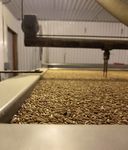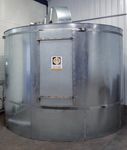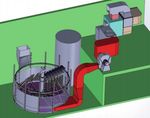MALTING EQUIPMENT And Technical Support - MaltBroue
←
→
Page content transcription
If your browser does not render page correctly, please read the page content below
MALTING
EQUIPMENT
And Technical Support
107 route 232 Est, Témiscouata-sur-le-Lac
Québec, Canada G0L 1E0
418-894-8820 | micromaltsolutions.comYour Project :
Malting Your OwnGrains
Before proceeding you need to answer these important questions.
What are your needs ?
1 Acquiring equipment and arranging building and outdoor space, often requires substan-
tial investments. Planning according to your needs, is the first step. Each case is different.
How many tons of malt per year are you planning on producing ? How are your current
facilities (building type, handling and cleaning equipment, silos, warehouse for finished
products, etc.). How much automation would you like for your operations. We can help
you plan your investments.
Do you have enough water and energy ?
2 Malting requires access to a large quantity of drinking water, 3 000 litres per ton of malt
produced. Do you have the facilities to treat that amount of waste water ?
Malting requires a lot of energy. You need to generate temperatures of up to 110°C in
order to produce the main malts (Pils, Pale, Munich). Which energy is available at your
location ? Electricity, 1 phase or 3 phase ? Propane ? Natural gas ? Biomass ? You need
about 45kw per ton of grain.
Supply of raw materials
3 Are your supplies of brew-grade grains readily available ? Do you have a grain centre near
your location that offers grain cleaning service ?
Our goal is to share our know-how
with you. We malt with the equipment we
have been developing for MaltBroue Inc.
for more than 10 years.
2Malting
Procedures
Note: the process time may vary depending on the type of malt produced.
Steeping (48 hours)
To initiate germination, the grains must be moistened, either
by steeping them in water or by wetting them. At this stage, the
grains must increase from about 14 % humidity to over 45 %.
The best is steeping the grains in a tank designed for this purpose,
but it is possible to do the 3 steps in the same equipment. This
helps to limit the initial investment.
Between the grain soaking periods, the tank must allow to
ventilate the grain.
Germination (48 to 96 hours)
During the germination period, the grain heats up and the
temperature must be controlled.
The grains should be mixed regularly to prevent the rootlets
from entangling and causing problems later in the process.
The cold slows down the germination and the heat can trans-
form the grain too quickly. Germination should be stopped just
before the germ sprouts.
If the germ appears, then we are dealing with a grain that is
too processed and unsuitable for brewing. Once this step is
completed, we obtain what is called « green malt. »
3The Kilning (24 to 35 hours)
Kilning is a term for drying sprouted barley. It involves drying malt
grains to less than 5 % moisture. The temperature and the various
temperature levels will have an impact on the malt.
Depending on the equipment, the malt can dry with tempera-
tures of up to 190°C (375°F). This allows to produce a variety of
malt, from base malt to specialty malt with colours ranging from
2° to 160° Lovibond, using the standard analysis method of the
American Society of Brewing Chemist (ASBC) or from 4° to 315°
EBC (European Brewery Convention).
The process consists of pushing the ventilation to the
maximum in order to extract moisture quickly using as little
energy as possible.
Drying temperatures may vary depending on the type of malt you
would like to get. The grains are mixed regularly to ensure even
drying. Wetting is obviously cut off at this stage but the heating is
at its peak.
The finished product remains a whole grain, the transformation of
which is not always visible to the naked eye except for the colour.
Our Achievements
MaltBroue Inc. Island Malting House
Témiscouata-sur-le-Lac, QC New Glasgow, IPE
Drum System Cylindrical kilning system
1 ton - 2008 3 tons - 2018
2 tons - 2013
Distillerie Fils du Roy
Malterie Caux-Laflamme Petit-Paquetville, NB
St-Narcisse-de-Beaurivage, QC Currently being Installed
Saladin System All-in-One Cylindrical System
5 tons -2016
4Malting System and
related equipment
Malting system Steeping tank Cleaning
The malting system can per- To double production by
equipment
form all 3 stages (steeping, minimizing investment, the A system for cleaning the bar-
germination, kilning) all in the steeping stage can be done ley to remove the maximum
same vessel, which helps to in an adjacent tank with this amount of impurities (foreign
limit initial investments. function. grains, rocks). Note that this
step can also be done at a
• 1 ton • 3 tons Pouring equipment must be local grain centre.
• 5 tons • 10 tons provided for this purpose.
Vacuum and pressure washer
for washing tanks after use.
Storage A dust remover can also be
A perforated-bottom storage considered depending on
silo with a fan is necessary the building used as well as
to maintain the germination equipment to separate root-
power of barley and avoid lets from malt.
insect or other infestations.
A heated warehouse and plas-
tic lining bags for the finished Handling
product. A grain screw with a funnel at
the entrance and a reversible
engine to load and unload
the tanks for equipment of
Laboratory 1 to 2 tons. For larger tanks,
It is recommended to have loading and unloading is
your products tested by an done by suction.
accredited external laboratory.
However a moisture scale is
absolutely necessary on site.
A friability tester is also an
investment to be considered to
reduce analysis time.
5Technical Specifications
of Equipment
Malting Tank
• The Inside of the tank and all elements in direct contact with
the grains and water are made of 304 stainless steel.
• The tank is insulated with an anti-mould mineral wool.
• The exterior coating is made of galvanized steel.
• The top of the tank is covered by a non insulated stainless steel
wall to push moist air to the air ducts.
• The structure of the tank can accommodate a steeping
tank on top for future needs.
• Bridge and access ladder.
Ventilation
• The ventilation system includes a centrifugal fan, a butter-
fly valve flow, an axial fan, an aluminum heat exchanger and
all galvanized steel ventilation ducts that lead to the interior
of the building. The strength of this system depends on the
capability of the malting equipment.
Automation
• The rotating system(mixing screws) is controlled by a drive and
a crane system. The speed of movement can be controlled.
• Heat from the heating system (at the customer’s expense)
will be controlled by the automaton.
• Automation and control are carried out by an Internet-
connected automaton.
• The system is equipped with sensors to control temperature,
air flow, static pressure and air humidity.
Safety
• Emergency stops suitable for the selected equipment are
installed in different locations.
Installation, training and 1-year warranty included
6Quality and
Research &
Development
Our partners :
Hartwick College Center for Craft
Food and Beverage, New York
Pre-commercial centre for
bioprocess technologies of the
New Brunswick Community College
Contact
Member of :
Dany Bastille
Craft Master Guild Association des Mechanical engineer and maltster
microbrasseries du Québec 418-894-8820
dany.bastille@micromaltsolutions.com
107 route 232 Est, Témiscouata-sur-le-Lac
Québec, Canada G0L 1E0You can also read



























































